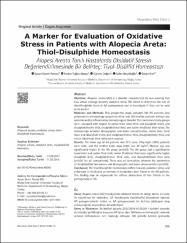| dc.contributor.author | Pektas, Suzan Demir | |
| dc.contributor.author | Alataş, Emine Tuğba | |
| dc.contributor.author | Doğan, Gürsoy | |
| dc.contributor.author | Neşelioğlu, Salim | |
| dc.contributor.author | Erel, Özcan | |
| dc.date.accessioned | 2020-11-20T14:49:49Z | |
| dc.date.available | 2020-11-20T14:49:49Z | |
| dc.date.issued | 2018 | |
| dc.identifier.issn | 2149-9063 | |
| dc.identifier.uri | https://doi.org/10.4274/meandros.48303 | |
| dc.identifier.uri | https://app.trdizin.gov.tr//makale/TXpBMk5ETTBOQT09 | |
| dc.identifier.uri | https://hdl.handle.net/20.500.12809/1355 | |
| dc.description | 0000-0002-5727-9474 | en_US |
| dc.description | WOS: 000446726700004 | en_US |
| dc.description.abstract | Objective: Alopecia areata (M) is a disorder characterized by non-scarring hair loss, whose etiology involves oxidative stress. We aimed to determine the role of thiol/disulphide levels in AA pathogenesis and to investigate if they can be used as its marker. Materials and Methods: This prospective study included 100 AA patients who presented to dermatology outpatient clinic and 100 healthy controls without any systemic and/or inflammatory dermatological disorder. The control and study groups were compared with respect to native thiol, total thiol, and disulphide levels, and disulphide/native thiol, disulphide/total thiol, and native thiol/total thiol ratios. The relationships between demographic and lesion characteristics, native thiol, total thiol, and disulphide levels, and disulphide/native thiol, disulphide/total thiol, and native thiol/total thiol ratios were studied. Results: The mean age of AA patients was 37.5 years. Fifty-eight (58%) patients were male, and the median body mass index was 24 kg/m(2). Median age was significantly higher in the AA group (p<0.05). The AA group had a significantly lower total and native thiol level, native thiol/total thiol ratio, significantly higher disulphide level, disulphide/native thiol ratio, and disulphide/total thiol ratio (p<0.05 for all comparisons). There was no correlation between the parameters of thiol/disulfide hemostasis and demographic and lesion characteristics (p>0.05). Conclusion: The thiol/disulphide homeostasis shifted towards oxidative stress, and a decrease in thiols and an increase in disulphides were found in the AA patients. This finding may be responsible for diffuse destruction of hair follicle in the pathogenesis of AA. | en_US |
| dc.item-language.iso | eng | en_US |
| dc.publisher | Galenos Yayincilik | en_US |
| dc.item-rights | info:eu-repo/semantics/openAccess | en_US |
| dc.subject | Alopecia Areata | en_US |
| dc.subject | Oxidative Stress | en_US |
| dc.subject | Thiol-Disulphide Homeostasis | en_US |
| dc.title | A Marker for Evaluation of Oxidative Stress in Patients with Alopecia Areta: Thiol-Disulphide Homeostasis | en_US |
| dc.item-type | article | en_US |
| dc.contributor.department | MÜ, Tıp Fakültesi, Dahili Tıp Bilimleri Bölümü | en_US |
| dc.contributor.institutionauthor | Pektas, Suzan Demir | |
| dc.contributor.institutionauthor | Alataş, Emine Tuğba | |
| dc.contributor.institutionauthor | Doğan, Gürsoy | |
| dc.identifier.doi | 10.4274/meandros.48303 | |
| dc.identifier.volume | 19 | en_US |
| dc.identifier.issue | 3 | en_US |
| dc.identifier.startpage | 205 | en_US |
| dc.identifier.endpage | 210 | en_US |
| dc.relation.journal | Meandros Medical and Dental Journal | en_US |
| dc.relation.publicationcategory | Makale - Uluslararası Hakemli Dergi - Kurum Öğretim Elemanı | en_US |


















